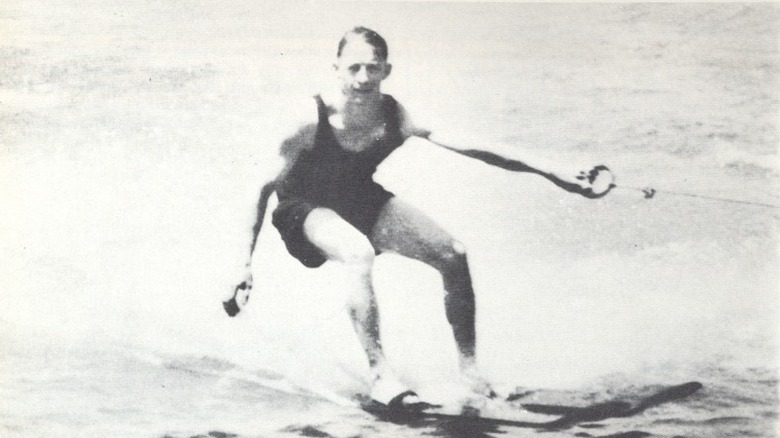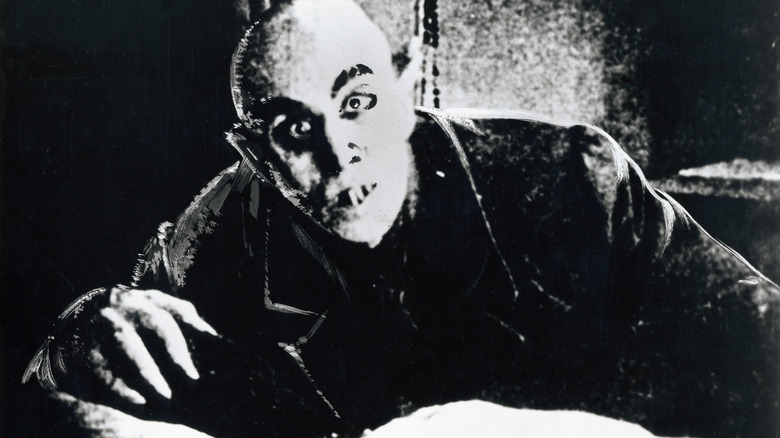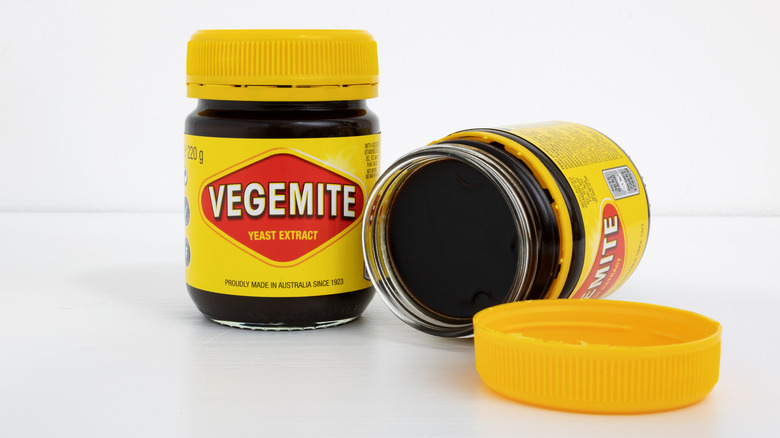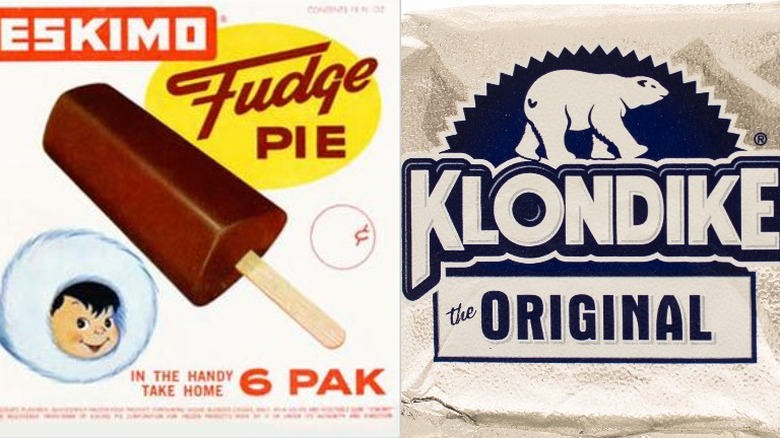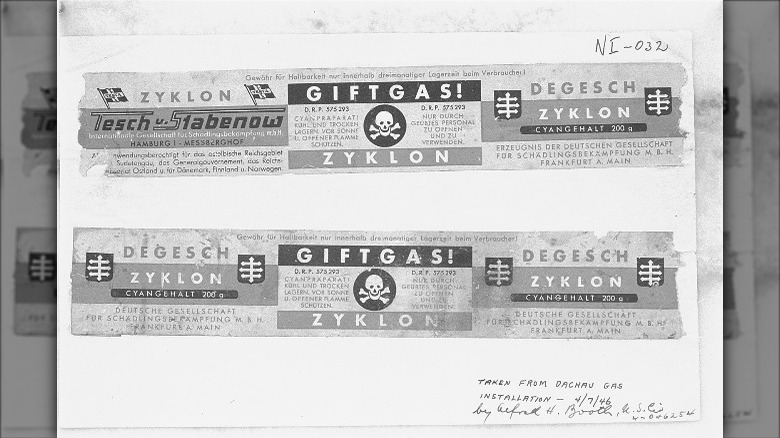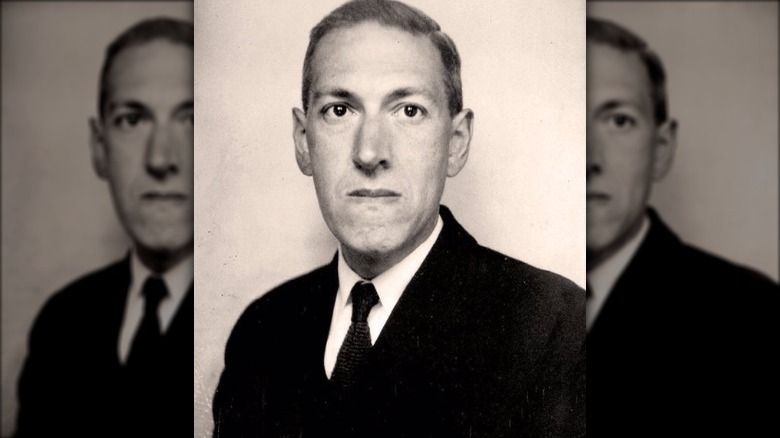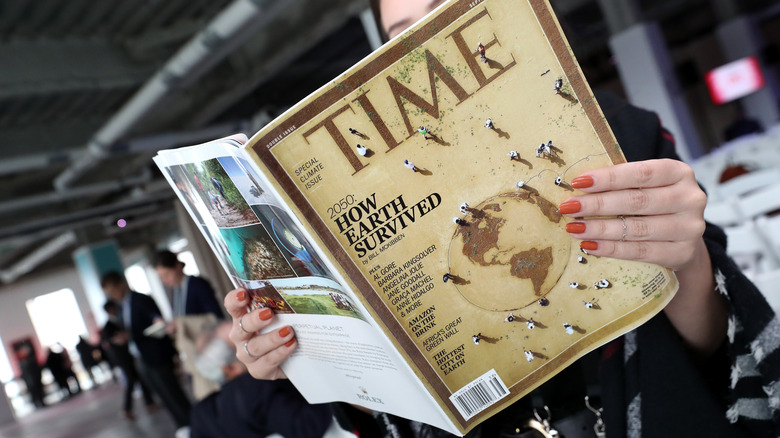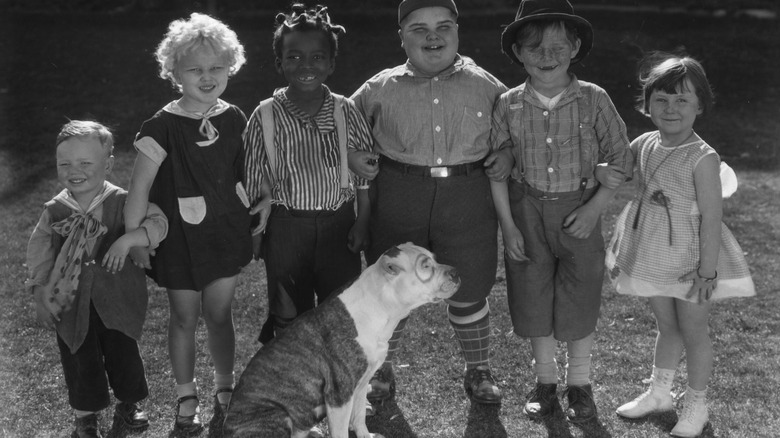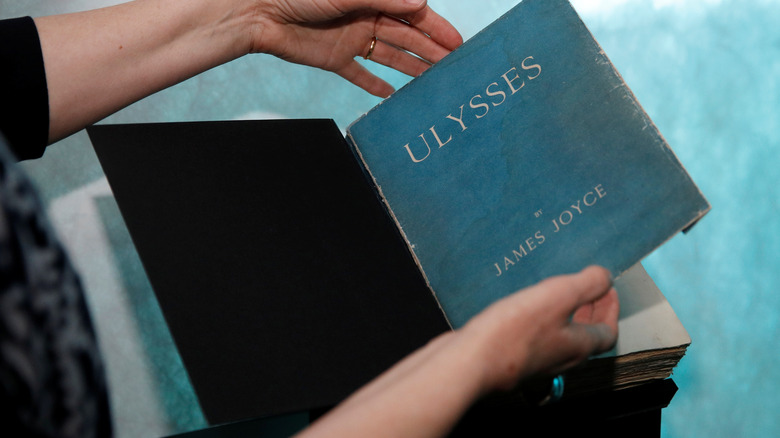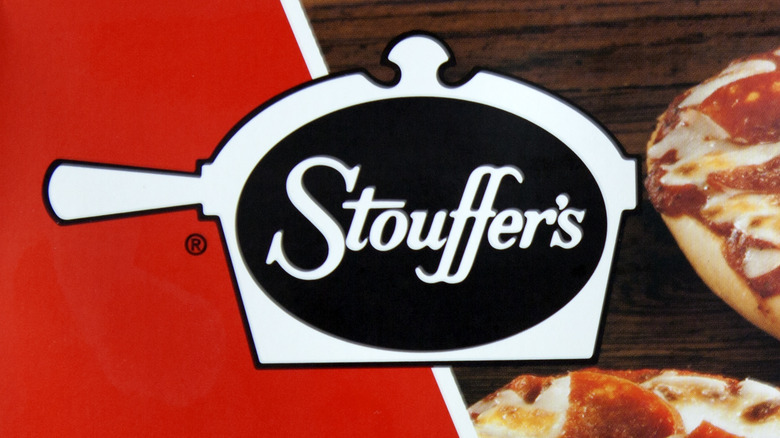20 Things Turning 100 In 2022
If a time traveler got picked up out of 1922 and dropped into 2022, it's kind of mind-blowing to think about everything that would look different. Technology has advanced in leaps and bounds, and it's not just a matter of things like satellites, television, and Netflix. A century ago, things like hamburgers and Coca-Cola were the hip new things that all the kids were into. It was only in 1916, says Futurism, that the first supermarket opened — it was the Piggly Wiggly, and it opened in Memphis, Tennessee. John D. Rockefeller had just done something unthinkable when his personal wealth crossed the billion-dollar threshold, and how about those speed limits? Most roads were capped at a death-defying 10 mph.
What about smartphones? Oberlo says that in 2021, the number of smartphone users across the globe rose to 6.4 billion. Just about 100 years ago — in 1917 — just 8% of American homes had a telephone landline. And seriously: That's the kind of change that makes even the biggest skeptics think there just might be something to this whole alien thing after all.
The world has come a long way in just 100 years, so let's take a look at some of the things that will be celebrating their 100th birthday in 2022. Some? They're more than a little unexpected.
Water skiing
In 1982, the USA Water Ski & Wake Sports Foundation inducted Ralph Samuelson (pictured) into their Hall of Fame. It's kind of surprising it took them so long to do so — Samuelson didn't live to see it, he had died in 1977 — because without him, there would be no such thing as water skiing.
It was the day before Samuelson's 19th birthday when he and his brother were experimenting with boats and skis on Minnesota's Lake Pepin. He came up with the idea to tilt the skis and let the boat pull him along and then — with the help of some scrap pieces of leather and a tape-wrapped iron ring — water skiing was born, at a speed of about 14 mph.
That was in July of 1922, and Samuelson went on to not only become the first to jump while water skiing, but when he hit 80 mph, he became the first speed water skier, too. It's kind of not surprising that the skis on display at the organization's museum aren't his originals: He broke those long ago.
Nosferatu
Vampire movies of all different kinds — and with different levels of sparkle — have been all the rage in the 21st century, but they're all pale imitations of the original, which turns 100 in 2022. When "Nosferatu" was released in 1922, it helped define what horror movies could — and should — be, but it almost didn't see the light of day.
At a glance, there aren't many similarities between the vampires themselves, Bram Stoker's "Dracula" and the ghoulish Count Orlock. Still, CBR says that the official story is that "Nosferatu" was an adaptation of Stoker's turn-of-the-century work, and to be more specific, it was an unauthorized version. The production company behind "Nosferatu" had started with "Dracula," and when Stoker's widow refused to sell the rights, they changed all the names, called it good enough, and started filming.
Three years after the film's 1922 premiere, Stoker's widow didn't just win her lawsuit, but the courts ordered all copies, negatives, and prints of "Nosferatu" destroyed. Many were, and the movie almost didn't survive. However, in a story that weirdly parallels Dracula's own tale, copies of the film were taken overseas (to the U.S., and it's nice to imagine there was a coffin involved), where an accidentally expired copyright meant the story was in the public domain. Fly free, Count Orlock!
Vegemite
Vegemite is the food that makes Australians think of home, makes the British fiercely protective of their own yeasty extract, Marmite, and makes Americans very, very confused. How aggressively Australian is it? According to the National Museum Australia, it's long been marketed as a national symbol that embodies "Australian vitality and innocence," and when it comes to the food that makes ex-pats dream of home, it's Vegemite.
The simple spread was created by a chemist named Dr. Cyril P. Callister, who had been hired by the Fred Walker Company and given instructions to come up with something that was sort of like Marmite, and used the same brewer's yeast. (Why? It's an excellent source of vitamin B.)
Marmite was already wildly popular in Australia, and the weird thing is, this titular Aussie staple languished in near obscurity for years. It wasn't until a 1937 contest — that promised cars and other prizes to the winners — that people started reaching for Vegemite over Marmite. That aforementioned vitamin B meant that it wasn't long before it became doctor-recommended, and World War II — with a deep longing for home — cemented this now century-old spread in the hearts of Australians everywhere.
The BBC
While most people might have 24/7 access to the news, weather, and sports scores today, it's easy to forget that wasn't always the case. As radio and television became more and more popular, those tuning in were likely to hear amateur stations — until November 14, 1922. That's when the then-named British Broadcasting Company made their very first broadcast, and a century later, they remain a go-to for everything from news to entertainment to sport, have an international presence, and employ around 23,000 people.
What was that first radio broadcast? According to the Oxford University Press, Arthur Burrows went on-air at 6 p.m. to deliver a news bulletin that awesomely included an update about a train robbery. Other stories were a little more familiar to modern ears, and those who tuned in to that very first broadcast heard about political goings-on, the weather, and sports scores.
The BBC didn't have a general manager until exactly a month later, and Charles Walsham Reith later explained, "I hadn't the remotest idea as to what broadcasting was."
The Eskimo Pie/Edy's Pie and the Klondike Bar
In 2021, ice cream giant Froneri announced (via FoodDive) that they were going to be changing the name of one of their most iconic treats. The Eskimo Pie wasn't exactly an acceptable name in an era of political correctness and sensitivity, so the chocolate-covered ice cream treat was going to become Edy's Pie, as a nod to ice cream innovator Joseph Edy.
The name change came just in time for the dessert's 100th birthday: According to the Smithsonian, the Eskimo Pie was patented on January 24, 1922. The idea came about when a teacher and sweet shop employee saw a boy debating whether he wanted to spend his nickel on a chocolate bar or an ice cream. After a ton of experimentation, Christian Kent Nelson found a way to combine the two, and the rest is history... but like a lot of history, there's a footnote to this one.
There's another chocolate-covered ice cream treat turning 100 in 1922, and that's the Klondike bar. And... the York Daily Record says Klondike, the Eskimo Pie, and Good Humor bars didn't just all debut in 1922, they all hit shelves in the same three-week span. Clearly, it was a good year for ice cream.
Zyklon B
Not everything that makes it to a 100th birthday is a good thing, and case in point? Zyklon B. That is, of course, the chemical that's most famous for being used in the gas chambers of World War II, creating horrible sights like the one recounted by Auschwitz commandant Rudolf Höss (via the Jewish Memory and Holocaust in Ukraine Museum): "Only after a few hours, the doors were unbolted... It was the first time that I saw this many bodies of people killed by gas... I was petrified by the sight. ... I never had any second thoughts about killing the Soviet prisoners. It was the order which I had to follow."
Zyklon B wasn't originally meant to be a weapon of mass slaughter. On June 20,1922, a patent application was submitted to the German Corporation for Pest Control, and for a long time, that's exactly what it was used for: a pesticide. As unthinkable as it is, the chemical concoction of granulated prussic acid was rebranded after the war, and until 2015, it was still being used as a pesticide.
Between 1942 and 1944, around 56 tons of Zyklon B was sold to and used in Nazi concentration camps.
Lincoln Memorial
It's one of the most famous buildings in the United States, and it's turning 100 years old in 2022.
Construction on the Lincoln Memorial started in 1914, says the National Park Service, and when it was officially dedicated and opened to the public on Memorial Day of 1922, it was soon enough after Lincoln's presidency that his son, Robert Todd Lincoln, was there to see the massive statue of his father unveiled.
Modeled after the Parthenon in ancient Greece, the Lincoln Memorial was made with a variety of stone — pink marble from Tennessee, granite from Massachusetts, marble from Colorado, Georgia, and Alabama, and limestone from Indiana — to symbolize not just one of the nation's most influential presidents, but the importance that the union of states held for him. Since it was unveiled, it's hosted equally monumental events (like Martin Luther King Jr.'s "I Have a Dream" speech) and is visited by hundreds of thousands of people every year.
The Necronomicon
The "Necronomicon" shows up in scores of horror movies and novels, but the very first time this deadly, demonic book was mentioned, it was in a short story by H.P. Lovecraft. "The Hound" was published in "Weird Tales" in 1924, but according to Tor, Lovecraft first wrote the story in 1922. So, that's when the book was "born," probably kicking, screaming, and dragging some demons up from the depths of hell along with it.
The story is about two grave robbers who head to Holland and a 500-year-old tomb. When they dig up the surprisingly well-preserved skeleton, they see it's been buried with a jade amulet: "... we recognized it as the thing hinted of in the forbidden "Necronomicon" of the mad Arab Abdul Alhazred;" That's really all it takes to make your skin crawl, and that's it for the mention of the book that went to be featured throughout the horror genre as the bound-in-skin source of all that is evil in this world... and all others. Happy birthday!
Time Inc.
Time Inc. is the media conglomerate that Quartz describes as having a history that's "ridiculously convoluted," and it all kicked off with the company's founding on November 28, 1922 (via Forbes). That was when Yale classmates Henry Luce and Briton Hadden started the company that would start publishing Time magazine the following year, but that was far from it.
Over the years, the Time Inc. empire has included Life magazine, Entertainment Weekly, Sports Illustrated, and — through the acquisition of Warner Communications (which became Time Warner), they developed pay-per-view television and premium channels like HBO. Also in the mix was Hollywood giant Warner Bros., the Turner Broadcasting System, and much, much later, AOL.
These other companies have come and gone, with some spun off, sold, and restructured. Bottom line? A century on, it's still a multi-billion-dollar company that's changed the way we interact with and become informed about the world.
Our Gang/The Little Rascals
The franchise that started out as "Our Gang" and morphed into "The Little Rascals" when it made the jump from the silver screen to the small one is turning 100, as the original film — simply titled "Our Gang" debuted in 1922. Sadly, IMDB says that much of the original, 20-minute short about a group of kids who step in to help a shopkeeper targeted by an unscrupulous rival has been lost over the years.
That initial group of short films delighted Depression-era and World War II-era children right up to 1944, and according to The Wall Street Journal, there were a lot of them: 221, to be precise. Their enduring popularity came for a whole host of reasons, from the charm and relatability of the children themselves to the fact that although Jim Crow laws were the norm throughout much of the U.S., the cast of "Our Gang" featured a racially diverse cast of characters.
According to NPR, there was some pushback: Theaters who showed the films in the south could expect to be targeted by some protests, but at the same time haters were hating, Julia Lee, author of "Our Gang: A Racial History of The Little Rascals" explains the overall mentality toward the Black cast members: "They were absolute stars. They were considered saviors in many ways."
Comic books
Thanks to the widespread popularity of Marvel movies, comic books have seen a massive resurgence in popularity. It wasn't that long ago that they simply just didn't exist, and the concept of the monthly comic book debuted in 1922.
Book Riot says that there's quite a bit of debate on what the first comic book was, and since things like political cartoons and newspaper funnies had been around for centuries, here's where things get tricky. The not-at-all politically correct "The Yellow Kid" (and yes, it's really that much of a racial stereotype) was a comic strip that was published in book form in 1897, but that was just a collection of old strips that was sort of a one-time deal.
However, the idea of a monthly comic book came in 1922, with the publishing of the aptly (if unimaginatively) named "Comics Monthly." It, too, was a collection of comic strips that had already been printed in other media, but for the first time, publishers proved that there was a demand for regular, monthly installments of illustrated stories. Comics have never looked back.
Maidenform
There are some things that just seem like they've been around forever, and when it comes to clothing, sure styles may come and go, but bras were always a thing, right? Right?
Not precisely: According to the Jewish Women's Archive, the modern bra was only created in the 1920s. At the time, it was a boyish figure that was all the rage, and when Ida Rosenthal turned her seamstress business into an undergarment manufacturer, she copyrighted the name "Maidenform" to set her apart from others in the industry. Rosenthal registered her copyright in 1922, says PBS, and remained afloat even throughout the difficult years of the Depression and World War II. (The war, incidentally, gave the industry a boost as women were asked to donate corsets to the steel industry. They did, and they donated enough steel to build a battleship.)
It was about the same time that Maidenform became another first: When they kicked off a massive 1940s-era marketing campaign, they became the first women's intimate apparel company to advertise.
James Joyce's Ulysses
When James Joyce finally published "Ulysses" in 1922, the world went, "What?" and has been saying that ever since. Even though The New York Times called it the "most important contribution that has been made to fictional literature in the 20th century," they also said in their 1922 review: "the most attentive and diligent reader would eventually get some comprehension of Mr. Joyce's message."
Then, they described it as "prose with studied incoherence," and then went on to predict that only about 10% of the population would be either bothered to or capable of reading it. Fast forward to the 75th anniversary of Joyce's death, and The Guardian still agreed: Sian Cain called it one of the hardest novels to finish and said that she needed a nap after forcing herself to get through 40 pages. That's not surprising, considering it's filled with verses like this (via GoodReads): "Open your eyes for now. I will. One moment. Has all vanished since? If I open and am for ever in the black adiaphane. Basta! I will see if I can see. See now."
And so on, and so on. That hasn't kept people from trying, though, so how about giving it another go on birthday 100? Then, let the rest of the world know what it's about.
The electric blender
It's the little things that can make the day bearable, and milkshakes are definitely one of those things. Fans should celebrate a 100th birthday in 2022, then, not of the milkshake itself, but of the device that makes them so much easier to make: the electric blender.
It took Polish immigrant Stephen Poplawski about four years to invent and perfect the electric blender before applying for his patent in 1922. He had originally been hired to come up with a machine that would make working in a malt shop and prepping all those delicious shakes much easier, and his device with a base-mounted "agitator" and cup was so popular that the company who hired him — Arnold Electric Co. — became wildly successful and was ultimately folded into Hamilton Beach. The Wisconsin Historical Society says that he then went on to invent a home version in 1933, and a hand-held mixer in 1940. Good news! That makes baking a birthday cake much, much easier.
The Hollywood Bowl
Discover Los Angeles says that when it comes to things that make the city the incredible place that it is, the Hollywood Bowl is definitely up there. They kicked off their first season of concerts and events on July 11, 1922 — and they haven't looked back. In the years since those first concertgoers sat on wooden benches to listen to the Philharmonic, the venue has hosted everyone from poets and composers to The Doors and Monty Python.
What's going on here is pretty fascinating: The Hollywood Bowl was built in a location in the Hollywood Hills that has some incredible, naturally occurring acoustic properties. Add in the surrounding scenery and bandshells that have — throughout the years — been designed like people including the son of Frank Lloyd Wright, it's safe to say that it isn't just a venue, it's an experience.
How about a few fun facts, via Thrillist? Record attendance at the venue was set in 1936, when 26,410 people turned up to see the French singer Lily Pons. Photos of the event seem to show her walking across what looks like a pool, because there was a pool. It was, unfortunately, drained in 1972. But even better? It's open to the public most of the time, even during many rehearsals and sound checks. Fun!
Reader's Digest
Reader's Digest was way ahead of its time: 100 years ahead, to be exact. While social media and the internet have conditioned 21st-century minds to like little bite-sized pieces of news and entertainment, Reader's Digest was doing that way back in 1922.
According to Funding Universe, DeWitt Wallace got the idea from his own habit of making notes as he read. If notes were handy for him, he reasoned, others might appreciate them, too. So, he decided to start a magazine that would essentially take full-size articles, condense them down to more manageable, abridged versions, and compile them into a magazine he'd sell via the mail.
It was a massive hit, and he had nearly a quarter of a million subscribers by 1929. Condensed books were added in 1950, and although the publication had some 21st century struggles and bankruptcies, CNBC says new management turned things around with a digitally-focused rebrand.
Radial arm saw
Anyone in the construction or woodworking industry is familiar with a radial arm saw, and for the rest, it's basically a machine that has a saw blade mounted to a platform and allows the user to maneuver wood around in order to more easily cut it (via Monroe Engineering). Pretty straightforward, right?
The radial arm saw is a big deal for a few reasons. Not only did it make carpentry much easier and safer, but it also helped launch one of the biggest companies in construction equipment today: DeWalt.
Raymond DeWalt was working at a place called Seabrook Farms when he invented the radial arm saw in 1922, and as one of the higher-ups, he'd been looking for something to make his employees more productive. Realizing that the saw had huge commercial possibilities, he went on to found DeWalt Products Company just two years later. Selling the saw along with a few other power tools, his new-fangled gadgets and gizmos did so well that he upgraded their location in another five years. A full 100 years after that first invention, DeWalt remains an industry leader.
Reiki
Reiki, says the University of Minnesota, is a form of therapy where practitioners hold their hands on or above a person's body in order to heal them. It sounds like an ancient and mystical process, right? They also say that it dates back to 1922, and a lay monk named Mikao Usui.
Usui credited his life-long spiritual practices and exposure to the different beliefs of Shintoism, Buddhism, and Taoism for allowing him to develop the practice of Reiki, which he discovered in "a profound revelation" just 100 years ago. Originally training just 16 Reiki masters, Usui saw his teachings spread largely thanks to one of his original students, Chujiro Hayashi. Although the Reiki that is taught and practiced today is pretty different from the original form, the basic principles remain the same.
How and why does it work? U of M says no one's quite sure what's going on, and current scientific research is still in the "theory" territory.
Stouffer's
Love a quick and easy meal that's hearty and filling along with being premade? Stouffer's lasagna has been a staple in the freezers of busy homes for decades, and it all started in 1922.
That, says Case Western Reserve University's Encyclopedia of Cleveland History, is when Abraham and Lena Stouffer turned one of their family's Medina County Creamery stands into a restaurant, and started serving things like sandwiches and homemade apple pie. It was the pie that was a major hit and allowed them to keep expanding. Their sons opened restaurants of their own, and by the 1950s, their food was in such high demand that they started selling par-cooked meals to go. Founder A.E. Stouffer had died in 1931 and didn't get to see this part of the business's success, but it had remained in the hands of his sons. They absolutely took it to the next level when they founded their frozen food division: It's easy to see how and why it became so popular, and it all started when they opened their doors a century ago.
The Velveteen Rabbit
Childhood isn't complete unless it involves some serious heartbreak and nightmare-inducing stories, and while tales like "Bambi" certainly fit the bill, the little deer who loses his mother to a hunter's bullet isn't the only traumatic childhood tale.
Let's talk about "The Velveteen Rabbit," the 1922 story of a toy rabbit who is initially tossed aside by the child who gets him as a Christmas gift. The boy eventually becomes attached to the rabbit and imagines him to be a real, flesh-and-blood bunny. Things get super dark when the boy nearly dies of scarlet fever, and in order to disinfect his room, all his possessions — including his beloved rabbit — are thrown on a pile for burning. Before that can happen, a fairy appears and grants the rabbit's wish: to become a real rabbit. He escapes the fire, but those who read it definitely didn't escape the heartbreak.
In fact, Penn State University Libraries said that ever-present themes of sadness were one of the biggest criticisms of author Margery Williams Bianco's work. She believed that no one could grow up, mature, and change without a little sadness, and so this incredibly sad tale has now been giving kids a complex about their stuffed toys for 100 years.

